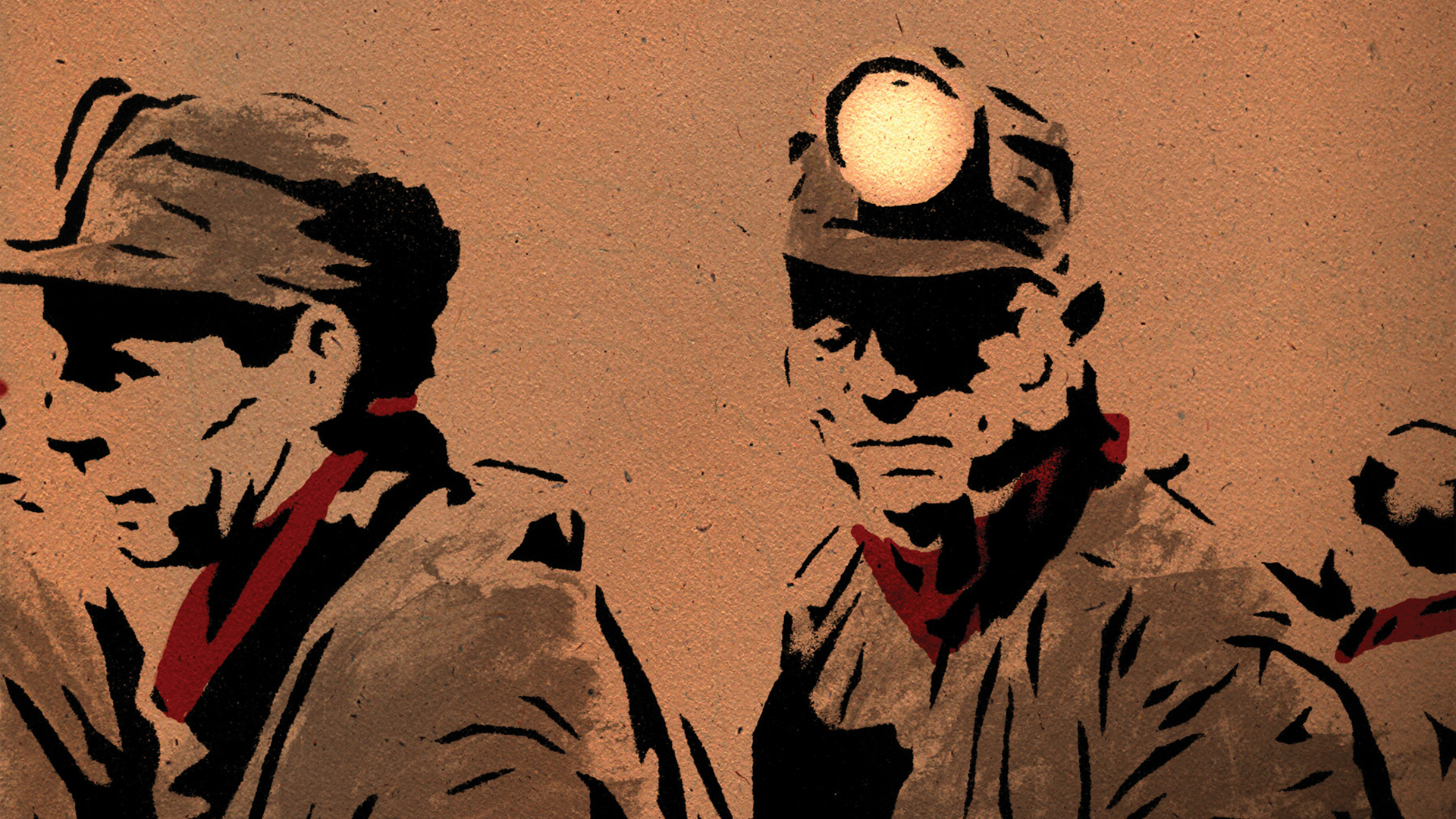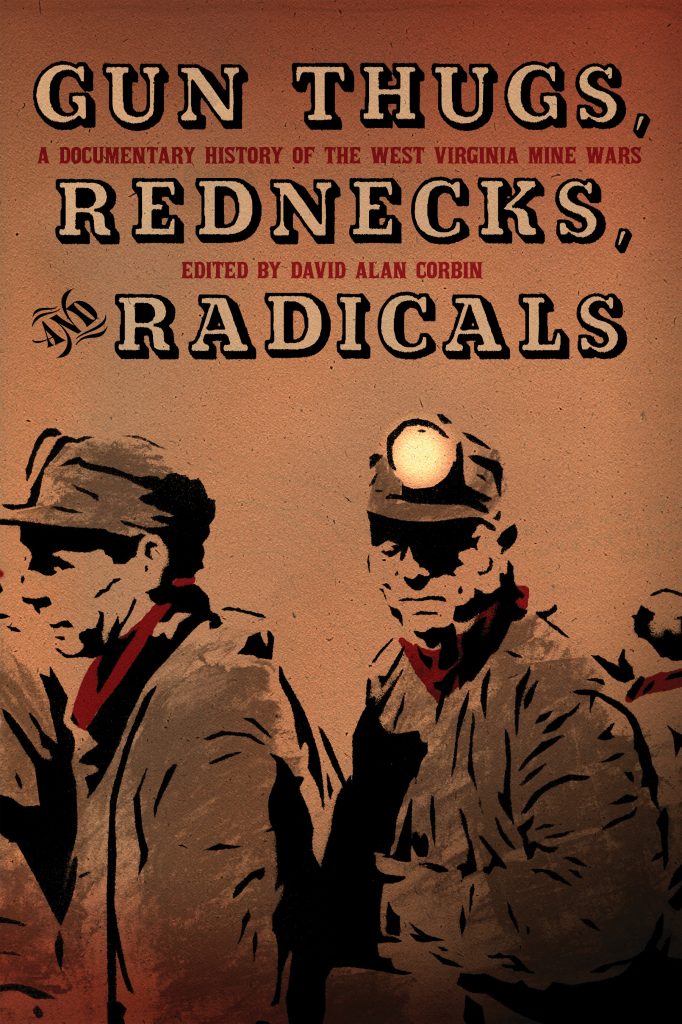by Sasha
EF! Journal
Brought together by historian, David Alan Corbin, Gun Thugs, Rednecks & Radicals presents an archive of mostly-out-of-print historical documents forged by labor leaders during the West Virginia Mine Wars and especially the Battle of Blair Mountain. It is, in effect, 250 pages of labor history throw-down that has powerful reverberations for the environmental movement today.
From even before the book begins—in the Preface—Gun Thugs, Rednecks, Radicals positions itself as a book of the utmost urgency for the direct action environmental movement. It is worth quoting the passage at length: “There is yet another battle over the fate of Blair Mountain,” states Gordon Simmons of the West Virginia Labor History Association. “This time the stakes are whether or not the mountain will be devastated and leveled by coal industry giants such as Massey Energy and Arch Coal, not only in order to cheaply extract the mineral wealth beneath its surface, but also, by unhappy coincidence, to eradicate the physical terrain upon which workers engaged their class enemies. In 1921, the West Virginia coal miners fought as resolutely as other works did in those times—in Munich and Turin and Kronstadt—and met similar defeat. Such an outcome, however, did not resolve the cause of their struggle, but only prolonged it for another date.” By propelling the reader into the heat of contemporary struggle over the history and ecology of this vital place, Gun Thugs, Rednecks, Radicals summons a desire to assess strategies, tactics, events, processes, and potentials in modern and historic movements.
It is no coincidence that the first article in the anthology is a vivid description of the environmental effects of coal mining. Author Winthrop T. Lane notes how Appalachia’s “stony beds of mountain streams” and “forests of oak, ash, cucumber wood and poplar” transformed into “long lines of squat mine car run(ing) along their narrow gage tracks and disappear(ing) around the curves of the hills” where “large mouths gape blackly at you from the hillsides.” “The blackness of coal is over everything…. Peacefulness and quiet have departed.” Lane paints a desperate picture of ecological poverty and economic repression: “Four hundred thousand men, women and children in West Virginia are living this subservient existence. They are caught up in a civilization within a civilization—an alien order imbedded in democracy…. They cannot initiate or take part in any of those little ways of controlling one’s environment that are the common pride of normal small towns…. Any collective voice among them is smothered; they are the recipients of what others think is good for them.”
Soon after, the timeline proceeds with the 1912 Paint Creek-Cabin Creek Strike. Moving from accounts of important union leaders like Samuel Grompers and Mother Jones to first hand testimonies of miners and family members who suffered the brutality of the guards, the struggle whips forward at harrowing speed, breaking into the lash of the so-called Bull Moose Special, a train mounted with a gatling gun and loaded with armed company guards, which was sent to fire on the miners. The reader courses through the riveting congressional testimony of miners’ family, company guards, and finally the combative General Manager responsible for giving the order to fire.
What is captured in this primary-source approach is the familial nature of the struggle, as the place-based communities of Appalachia rise up against the extraction-oriented capitalists. Erecting tent cities and forging community forms of survival, the miners found a way to continue their existence together. It was through the strength of this unity and self-reliance and nothing else that the United Mine Workers Association would take hold in spite of the terrible weight of oppression.
The action quickly escalates, jolting from Sid Hatfield’s first-hand testimony of the Matawan Massacre to Hatfield’s wife’s account of her husband’s assassination at the hands of private “detectives”. Reporter Arthur Gleason sets the pace for the climax: “The Miners of West Virginia… have grown up in the presence of implacable feuds. They are generous, hospitable, but clannish, suspicious of strangers, swift in action. Bred in this climate of warm friendships and enmities to the death, they are now stirred by the industrial fight. All their buried memories of night terror and sudden killings are awakened by the present struggle. They revert to their ancient way of settling trouble, and that is by private hillside and woodland warfare. Today, wherever I have gone in southwest West Virginia, I find both sides armed. This section of the State is now a powder mine, ripe for blowing up.”
As for the actual Battle of Blair Mountain, real events swirl together in a firestorm of dramatic narratives and testimonies. From the treason trials against the miners to the Senate hearings that called up high ranking army officials, the book draws the reader through several different perspectives in a fast-paced flurry of events. What is accomplished is an understanding of the famous battle as more than simply an occasion, but a process of rebellious lives moving together with a purpose. We find that during the Battle of Blair Mountain, the people figure larger than the gun fights, the encampments, stories told, songs sung manifest the living, feeling history behind the shooting, bombings, and spies.
And of course, throughout the spectacle looms the lofty, jutting cliffs of Appalachia. “Rough mountains rise all about, beautiful in their bleakness,” writes James M. Cain, famed author of The Postman Always Rings Twice. “They are hard and barren, save for a scrubby, whiskery growth of trees that only half conceal the hard rock beneath. Yet they have their moods. On gray days they lie heavy and sullen, but on sunny mornings they are dizzy with color: flat canvases painted in gaudy hues; here and there tiny soft black pines showing against a cool, blue sky. At night, if the moon shines through a haze, they hang far above you, dim outlines of smoke; you could throw a stone right through them.” This is the land of solidarity and treason, “Where they give each other three-fingered handshakes, and slips of paper pass from palm to palm. Where hoarsely whispered plots are met by counterplots, and detective agencies flourish… Where murder, dynamiting, arson, and insurrection are the usual order of the day and night.”
EF!ers might actually relate to a lot of these words and the security culture, intrigue, and repression that they evoke. Perforce, Gun Thugs, Rednecks, and Radicals not only echos the story of Appalachia, which is resurrected in today’s struggle against MTR, but also pounds against the boundaries of political power everywhere people are resisting. From the border wall to the Cascadian forests back around to the frack fields of the Finger Lakes and down to the swampy bottoms of the Everglades, the story of peoples’ movements rising up from their place shares a common significance.
The book concludes with another familiar subject: a gutsy independent newspaper writing from the epicenter of the Appalachian struggle. Based in Huntington, West Virginia, The Socialist and Labor Star newspaper dared to report on the atrocities of the mining companies, detectives, and guards, and engaged in heated debate with other lefty compromisers and co-opters. Even the acclaimed Eugene Debbs would arouse the ire of this defiant newspaper, which snapped onto the leg of “Mr. Socialist” like a bull-dog and refused to cede ground. The battle between Debbs and the Star was only one of the many intense, internal fights that arose out of the chaos of the West Virginia Mine Wars.
Organizers met frequently with daggers drawn to contend for the hearts and minds of the movement. Mother Jones would castigate Samuel Gompers and the American Federation of Labor for coming to the struggle late, the UMWA would defy Mother Jones’s recommendation to stay nonviolent. As we continue the struggle in solidarity, it’s important for the environmental movement to remain conscious of the victories and ideas of the UMWA, and remember that Don Blankenship, CEO of Massey Coal, made his name busting that union from a membership of 120,000 in 1978 to just over 14,000 miners today. Gun Thugs, Rednecks, Radicals shows that union support in defense of the mountains is crucial to winning the struggle against MTR, but it also shows the kind of unglamorous resolve that it takes to mount and win a successful movement.
Check out marchonblairmountain.org and friendsofblairmountain.org for more…







